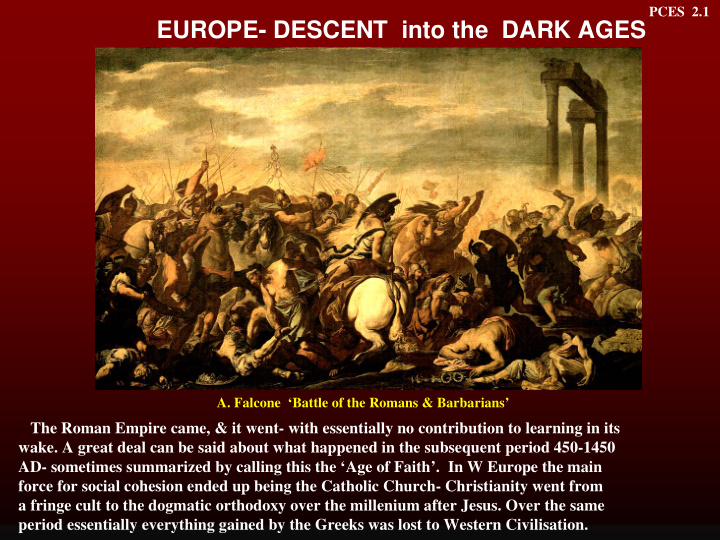



PCES 2.1 EUROPE- DESCENT into the DARK AGES A. Falcone ‘Battle of the Romans & Barbarians’ The Roman Empire came, & it went- with essentially no contribution to learning in its wake. A great deal can be said about what happened in the subsequent period 450-1450 AD- sometimes summarized by calling this the ‘Age of Faith’. In W Europe the main force for social cohesion ended up being the Catholic Church- Christianity went from a fringe cult to the dogmatic orthodoxy over the millenium after Jesus. Over the same period essentially everything gained by the Greeks was lost to Western Civilisation.
Influences from the East - the Silk Road PCES 2.2 For 1000 years after Rome fell, Europe was a backwater- the great centres of civilisation lay East. Chief amongst these were China, India, & various kingdoms ranging from Asia Minor to Bactria. Despite the enormous distance, a crucial trade route slowly developed between them- the Silk Road. Transporting silk, spice, metals, fur, etc, it provided crucial support to the Byzantine economy- & later to Mediterranean trading cities. It also brought artistic & architectural influences- & crucially, it brought fundamental work from Indian mathematics. LEFT: Mandala (Nepal, c. 1100) BELOW: Han ‘flying horse’ (bronze, 150 AD)
PCES 2.3 RISE of ISLAM The other great civilisation of the Middle Ages was Islamic. Starting in 610 AD with a handful of followers in the depths of the Arabian desert, and an idea, in 20 years Mohammad had converted all of Arabia to his ideas, embodied in his teachings (written down later as the Koran). Within 100 yrs Islam had spread east as far as India, & across Africa to Spain. At its height the Islamic empire was Koran- ink & Gold on vellum one of the most brilliant (Spain, 1300) civilisations in history, with dazzling innovations in art, architecture, literature, philosophy, & also science & mathematics. Then, quite suddenly, around 1200 AD, this innovative spirit was extinguished. Soon after Islam was decimated in the East by the Mongols (to remerge later in a King Yunan of Persia different form). (from ‘Arabian Nights) Gurgan arm bracelet (Iran, 1030 AD)
PCES 2.4 The Lifeline from Islamic Civilisation Maimonides (1135-1204 AD) Islamic philosophy was a curious fusion of ideas from Greek philosophy, Indian & Greek mathematics, & Islam dogma. A tradition of encycopedic compilation of knowledge developed. The best-known writers (in the Lindaraja garden (Alhambra) east, like Ibn-Sina [Avicenna, In spite of the turbulent 980-1037] & in the west, like history of the Arab world, Ibn-Rushd [Averroes, 1126-98], they preserved Greek & & the Jewish Maimonides (who Indian ideas (and even wrote in Arabic) all tried to extended mathematics). reconcile Aristotle with Above: the Alhambra in Granada (this This was transmitted to faith, & had huge influence is a Christian corruption of ‘Al-Qala Al- Europe later on, & was in mediaeval Christian Hamra’). Construction of modern crucial in stimulating Alhambra: 1238 AD et seq). Europe. the Renaissance.
PCES 2.5 Science & Mathematics in India & Islam The Indians were great innovators in mathematics (& to a lesser extent in astronomy). Our debt to them includes the modern number system, & the use of algebra, series expansions, & continued fractions in astronomy, going well beyond any Greek work. Indian astronomical works date back to 425 BC (the ‘Siddhantas’). 2 great figures from Gupta times are AryaBhata I (476-550 AD) and Brahmagupta (598-660 AD). They arrived at Al-Biruni (973-1048 AD) startling ideas- Aryabhata believed the A great project of translation of earth was round, spun on its axis, & ancient Indian & Greek works gave revolved around the sun- and that Islamic science a springboard- with planetary orbits were ellipses (ideas greatly superior instruments & new later suppressed, which never reached ideas in ‘al-jabr’ (algebra) & Europe!). geometry, Al-Khwarizmi, Alhazen, The fundamental invention of the & others developed ideas in optics & Al-Haytham place system of numbering, with the geography, & compiled celestial (’Alhazen’), zero, was imported into the Islamic 965-1040 AD tables still used 600 yrs later. world in 662 AD, along with the use of mathematics in physics T he incredible polymath Al- & astronomy. In the eastern flowering Biruni, from Khiva (in modern of Islam (starting in the reign of Harun Uzbekhistan) wrote 146 works al-Rashid, 786-809 AD), great libraries, covering all of science, history hospitals, and observatories were built (including a massive history of from Syria to Samarkand- & in Baghdad India), geography, & grammar- the “ Bayt al-Hikmah” (house of wisdom), & translated Euclid & Ptolemy Al-Khwarizmi the world’s first scientific academy. into Sanskrit. (780-850 AD)
PCES 2.6 TIDES of WAR Huge changes occured in the 12 th -13 th century; the Mongols drove as far as Europe, crushing Abbusid Islam & leaving in their wake the muslim Seljuk empire, which captured Constantinople (1453), defeated the Crusaders, & eradicated Christian ABOVE: Mongol empire, c.1280 BELOW: Krak des Chevaliers (Syria) influence in the East However the story in the West finished differently, with the expulsion of the Moors & the Jews from Spain by the Catholic powers. The stage was set for modern Europe. Ferdinand & Isabella (c. 1470)
Recommend
More recommend